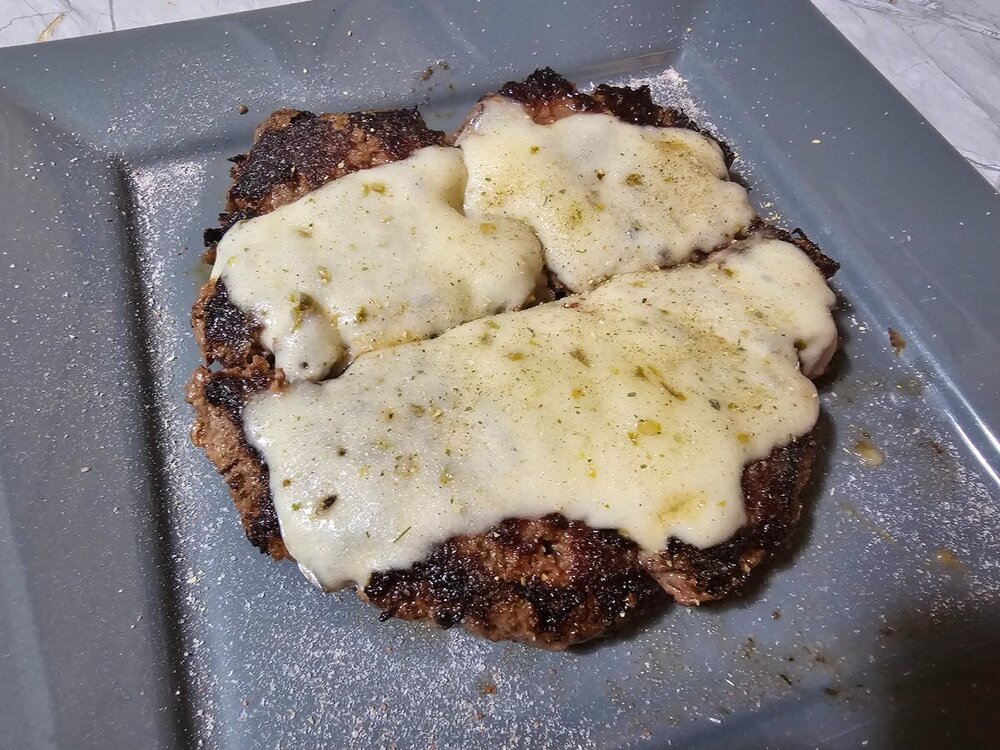Everything posted by Bob
-
Carnivore victories
Mosquitos generally eat everyone around me and leave me alone, lol. Unless we are in an area where there is just way too many of them, or I am the only person around to try to feast on, lol.
-
Greetings from Nashville
Keto is a good place to start, but we have to be careful how we define "keto". True keto is clean, whole, one-ingredient foods that God/nature provides. Aim to fill half your plate with fatty meat or eggs, and the other half with low-carbohydrate veggies. Gradually increase the meat and reduce the veggies over a set period of time until next thing you know you are fully carnivore. Try this for at least 30 days, preferably 90. A lot of people will experience the "keto flu" which is basically unpredictable stools, and then stop the diet and claim it doesn't work. You need to push past this transtion/adaptation phase. Took me 6 weeks. I've successfully reversed several of my issues, and my mental clarity and attitude has never been better. I think you will see the same results. So don't beat yourself up. Just be smart. Keep your actual carbs less than 20g a day to start. Avoid all sugar, grain, and vegetable seed oils. Of those things you listed, you may want to gradually wean yourself off the tahini. Sesame seeds contain a high amount of oxalic acid and phytic acid as well as other anti-nutrients like trypsin inhibitors, lectin, tannins, saponins. These anti-nutrients block mineral absorption and cause digestive distress when consumed. While hulling, toasting and cooking sesame seeds can reduce their anti-nutrient contents, it also lowers their nutrition value. We're here to help. And don't get too nervous about the festival. Just don't tell them you're eating a mostly carnivore diet. If you have to eat with them it's not the end of the world. I am going to a music festival in the morning - Sonic Temple in Columbus, Ohio. Once you're in, you can't leave, and you cannot bring anything in with you. I will probably have a massive breakfast and try to fast all day so I don't end up eating a $30 cheeseburger, lol.
-
Interesting video
Well, I listened to the whole interview. I kind of suffered through it, truthfully. I think the entire hour Dave Mac spoke maybe 3 sentences, lol. So, I work in construction, and oftentimes outside. I will get dirty and sweat like a hog. There's no way I am not going to shower, lol. My mouth will sometimes feel funky too. Although, if I brush before bed I will wake up with a super funky mouth. You would think this wouldn't be the case. Nor greasy crevices. I at least have to stand under some hot water and use some soap on the pits and bits.
- What Did You Eat Today?
-
🤔 What Are Your Thoughts On Grounding? 🤔
I had a thought earlier. I love summer. I feel better in summer. I'm also hanging out in my backyard in the pool and regularly barefoot on the ground too. Sun in the sky, wind on my face, feet on the ground. What's not to love? 😄
-
Only the rich were fat... once
I shared it because it pinpointed ultra-processed food specifically, which we're all in agreement with how terrible these foods are for ones health and well-being. I'm not sure what an "18-certificate" is (this is a British article and that's British jargon), I assume it's a warning label of sorts. That would be okay. The "rationing" and "restricting the sales of takeways" leaves me a bit confused too. But food education in the schools would be a good thing. True, this is a parent's responsibility, but we have a lot of irresponsible parents not-raising their children in today's world. And you have a point here. You know Big Food representatives would be sticking their nose and their dollars into shaping these guidelines and in the end nothing would change. But if they would actually push "hey, just eat single ingredient foods that God/nature provides and stay away from ultra-processed food that corporate man makes for profit" that would go a long way in helping shape young minds.
-
Only the rich were fat... once
Fat people are costing us all billions. It’s time to get tough I used to think the obese should be left alone – but they’re beginning to crush us WILLIAM SITWELL | 13 May 2024 • 6:15pm A sphere projecting against a plane: Only the rich were fat....once CREDIT: James Gillray, 1792 As I write, the 31st European Congress on Obesity is meeting in Venice. It’s the city that sinks, and it’s a metaphor for the world today sinking into ill-health and economic doom because of obesity. Delegates to the congress are discussing a new report that shows how obesity hampers economic growth, specifically because obese workers are twice as likely to take time off sick. And as Britain is among the fattest of Europe – almost two in three British adults are overweight or obese – that means that huge numbers of British workers may be off sick because of weight-related issues; the worst of such ailments being diabetes or heart-disease. Which means it’s no longer just their problem – the dilemma of the obese – it’s our problem too, because it’s our country and our economy. Obesity costs Britain more than terrorism, it increases the risks of more than 30 types of cancer, it costs the NHS £6.5 billion a year, and it’s pushing up welfare bills. It is making our country inefficient: fewer staff means customers may spend longer waiting for companies to pick up the phone or to get their new passport processed. So is it time we intervened? Hell yes. When it comes to the British obesity crisis, I’m afraid we need to get illiberal. How we got here is understandable. After the War, and rationing, adding a few notches to the belt felt like freedom. And in the ensuing decades, the transformation of our food culture represented extraordinary progress. As the War ended, kids passing grocery stores asked what those newly-imported bananas were. Now we can eat when we want, shop when we want and the world is our culinary oyster. But with that fabulous choice has come the devil’s twin horns of the industrialisation of food (ultra-processing et al) and the bad decision-making and ignorance that accompanies that freedom. And what has then turned that into a disaster is that those ultra-processed foods, (such as soft, white-sliced bread), fast food, takeaways and ready-meals are often cheap. They tend to be less nutritious and, when consumed without moderation, lead to obesity – especially if the consumers aren’t moving about as they should, let alone exercising. We need to fix this. To do so will take courage and a long-term vision and, sorry politicos, short-term unpopularity. But we have been here before, with seatbelts, with alcohol, with smoking. And we got through those pain barriers. We look back now aghast that it was once normal to light up in the office. Taxing the firms who manufacture sugary drinks, restricting the sales of takeaways, putting 18-certificates on fast food, ushering in a new era of rationing might all seem impossible. We have already gone too far. Well, there is a way. There is a route to compulsory good eating and to indoctrination. And that is through schools. By which I mean free school meals, in every school, and a very limited menu of choice. Were learning about food to become as much a part of the school day as a maths lesson, it would be the greatest social leveller of the 21st century. No more wretched, divisive (plastic) lunch boxes and generations understanding and appreciating a good diet. Would it be expensive to implement? Of course. We’re talking billions every year. But it’s a revolution that would in time transform this country. ARTICLE SOURCE: https://www.telegraph.co.uk/news/2024/05/13/fat-people-are-costing-us-all-billions-time-to-get-tough/
-
Daily Movement Goals
You know, I had never heard of these things until I saw Bill Nott in Alaska using one.
-
🤔 What Are Your Thoughts On Grounding? 🤔
I haven't investigated or researched this thoroughly, but I have heard a lot of people talk about the benefits of grounding, from Bart Kay to Paul Saladino, and more. Now that the weather is nicer, I have gone outside to stand barefoot in the lawn a few times. I need to think about and do this more often. EDIT: After reading the article in your blog post, I probably need to spend more than a few minutes at a time barefoot. The subject in your article grounded for 30 minutes daily.
-
Daily Movement Goals
So I walk the dog and hike local trails when the weather is nice. I recently stumbled across a deal on a used treadmill that I couldn't pass up. It's a very nice one and the previous owner just wanted it out of his basement. It's in my garage at the moment because I haven't decided where I want to put it. But one of my goals is to get my heart rate up and keep that blood flowing, lol.
-
Hello from UK.
Welcome aboard. I can't even imagine eating 300+ carbs a day anymore, lol. I'm sure at one time I was consuming a lot more than that. I like to watch Bart Kay as well. I don't watch every video, but there are some other channels I like that I watch, and then I will watch him analyze one of their videos and pick it apart, lol.
-
Hello Everyone
Welcome aboard. 6 months is a good goal. I know personally that carnivore has improved my mental faculties. I used to struggle with negative thinking and depression (not officially diagnosed, nor medicated) and now I have a completely different outlook. I hope you see some benefit.
-
Interesting video
I haven't listened to this one yet. I will try to squeeze this in on the way to work today.
-
Salt necessary?
Normally salt is benign and we encourage it. Salt is an electrolyte, and many people, when they go strict carnivore or lion diet, struggle with electrolyte deficiencies. You should be able to salt your food to taste without issues. If your kidneys are in good shape, they will excrete excess salt if needed. They will also strive to retain salt as necessary.
- What Did You Eat Today?
-
What Did You Eat Today?
I had to cook 2 NY strips last night before they went bad. Had one for dinner and then had the 2nd one for lunch today. The wife and daughter ordered pizza. She's coming around slowly though, lol. You'll be fine as long as there were no croutons, lol. I eat a salad once or twice a month. Once when I go out with the guy that works for me for lunch, and then sometimes when the family goes out to dinner and they choose a place where I don't feel like being too much of a pest, lol. I wonder who was the first person to eat lettuce or how it even became a thing. It's quite tasteless and boring without slathering some dressing on it.
-
Acronym / Word Expansion
The following acronyms have been entered into the database so that when you mouse over them, a small pop-up shows up explaining what the acronym means (new acronyms do not retroactively apply to older posts). If you have any more suggestions, feel free to mention them here. ADA (case sensitive) = American Diabetes Association ADS (case sensitive) = American Diabetes Society acv = apple cider vinegar bhb = beta-hydroxybutyrate bmr = basal metabolic rate ci/co = calories in, calories out evoo = extra virgin olive oil IF (case sensitive) = intermittent fasting iifym = if it fits your macros ir = insulin resistance mct = medium-chain triglycerides mufa = monounsaturated fatty acid nsv = non-scale victory omad = one meal a day pufa = polyunsaturated fatty acids SAD (case sensitive) = standard American diet sfa = saturated fats t1d = Type I (one) diabetes t2d = Type II (two) diabetes woe = way of eating I will keep the above list up to date. I just added the ADA and the ADS 🙂
-
The Very MEATY History of Treating Diabetes Before Insulin
Me too. I can understand Dr. Berry's anger disappointment with the American Diabetes Association. It's mind-boggling the garbage they put up on their website, such as recipes that are supposed to be "diabetic friendly" but is in reality a load of crap. I hope this new American Diabetes Society succeeds where it ought.
-
Beer interrupts ketosis and goes straight to your gut
One of these old books I uploaded to the Downloads Library was written by a guy that swore by eating meat and drinking liquor and nothing else, lol. LOL! My wife has to stay away from tequila. Too much tequila and she's balling her eyes out talking about her terrible childhood and how she's trying to be a good mom to our kids. It's a bit over dramatic. Other drinks don't do this to her. Just tequila.
-
Salt necessary?
Inflammation in what manner? Where at on or in your body? Generally speaking, if you're eating a strict carnivore diet devoid of ultra-processed foods with high sodium content, you can salt to taste without repercussions. But some people say salt causes them to retain water and experience some edema, so they keep their salt to a minimum or don't have any at all. I think Steak & Butter Girl doesn't use salt, if I recall. If you're not super strict, you could try to swap out the salt with some spices or seasonings. And I believe the No Salt brand salt substitute is made with potassium, which many carnivores struggle to get enough of as well. Yes, in the beginning I went once a week. Now I average 2, sometimes 3 a week at most. This is perfectly normal. There is very little waste from eating meat, so there is less to excrete. Personally, I find this to be a blessing 🙂
-
FAQ: Why does my post need moderator approval?
We don't get a lot of spam attempts, and every once in a while I think about turning this off, and then BAM! there are like 3 spam posts, lol. Approval can take awhile, especially of a newbie posts while I am at work or asleep because I have appointed any helping hands yet to be moderators.
-
Beer interrupts ketosis and goes straight to your gut
I still have a scotch or Kentucky bourbon once a month at my cousin's Open Mic night. I might have one also if I go to a concert or out for karaoke. Just one shot, and usually on the rocks. I used to have a shot or two every night to put me to sleep but now that I have been carnivore I don't need it. I had some red wines on my wedding anniversary, and I did just fine. Beer has been banned from my life for the last year because it is a high-carb grain-based drink (although I think the whiskeys are grain-based also). I was never a major drinker, and usually just a social drinker. Now I am just a shot a month away from being a non-drinker, lol. A brewery representative was giving away free samples at the concert of 4 of their beers. Free stuff is my weakness, lol. So I sampled all 4 (probably the equivalent of half a can or more) and then purchased the one I actually liked just to show my appreciation. As predicted, I am back to normal weight today.
-
Swearing on TV
Love that summary, as well as your 'salt the floor' analogy. I have to remember both of these 🙂
-
What Did You Eat Today?
So at Cedar Point yesterday I went to a place called Famous Daves outside the park, at the Marina, overlooking the lake, and they worked with me to stay on plan. I order a burger with pepper jack cheese + bacon + chopped pork + beef brisket and it they even fenagled the price so it didn't break the bank. It did have a squirt of BBQ sauce on top, which I didn't ask for but I am assuming it was in conjunction with the chopped pork, and it was so small it wasn't worth scraping off so I ate it. Earlier that day I had eggs, sausage, and bacon.
-
What Did You Eat Today?
That would be my wife, lol. She get's tired of beef, beef, and more beef, lol. You could try eliminating the dairy to see if it improves. The point of a strict carnivore, whether that's Lion Diet or something like beef, butter, bacon, and eggs, is eliminating every possible thing that could be bothersome to you. Then, after 30, 60, or 90 days, you slowly and gradually add back one food at a time - like one new food every 2 week, to test how your body will react to it. Many start with dairy because it's still an animal product. The itch could be poor diet, a particular plant or class of plants, dairy, etc. You just have to play this game of trying to figure it out. If you go complete Lion Diet and still itch, then it could be environmental or the detergent you use, etc. We're cool with those who still want to eat some keto friendly vegetables (keto/ketovore) or even some fruit & honey (animal-based) as part of your carnivore/carnivore-centric diet. We'll only shame you if you eat a Twinkie, lol






